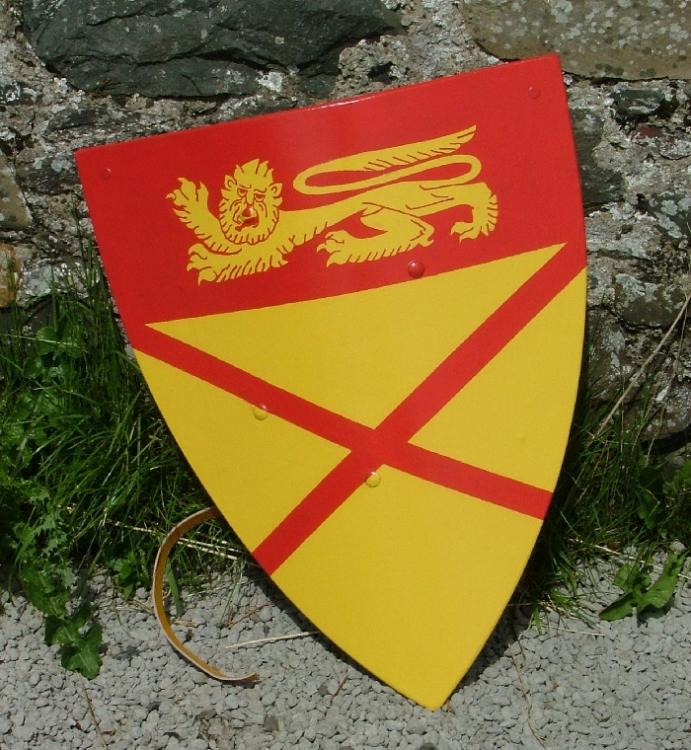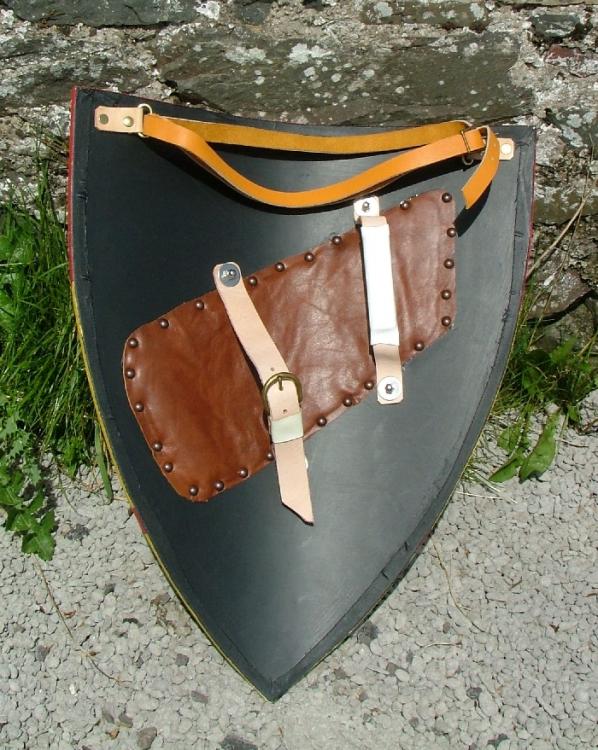-
Posts
5,931 -
Joined
Content Type
Profiles
Forums
Events
Blogs
Gallery
Everything posted by fredk
-
Try LePrevo in Newcastle, England. Email them, they're very helpful http://www.leprevo.co.uk/ 2/3rd down are the solid rivets; [Saddler's Copper Rivets] http://www.leprevo.co.uk/rivets.htm
-
I disagree on the strength of rapid rivets. The guige strap of this shield is held at each end by a rapid rivet thru the wood holding a short strap, then the main strap itself is held to that via a brass loop, that strap is closed by a rapid rivet. The shield weighs about 7 kilos [15.5 lbs approx]. Under test one of my team whirled this shield around his head by the guige strap; he did this for several minutes using great force. The test lasted nearly an hour, testing the security of all the straps. After this the rivets were inspected - they were still holding solid, and they continue to do so. All my shields have been in full contact battles and not one has failed in any way, and certainly not the ready rivets
-
With rapid rivets the stem should be 3mm to 4mm above the leather, eg on 3mm leather the stem should be 6mm long. Any longer than this and the head will want to go sideways as you blatter it down tight. You can get away with only 2mm beyond the thickness of the leather if you blatter it down real good and hard
-

Motorcycle Shifter Boot Protector
fredk replied to LearningCurveLeatherwork's topic in Motorcycles and Biker Gear
We just call it - 'elastic, the flat stuff'. aka 'Flat Woven Elastic' available by the yard in many widths in any haberdashery -
Exactly, no need to copy the pattern - in fact do not copy it. Adjust your stitch length for the thickness of your thread eg, a 1mm thread looks ok at 6 stitches per inch, 0.5mm thread looks better at 8 or 10 spi A stitching groove is handy, but only really necessary where the object will get wear on the thread area, eg on the soles of shoes. You can get stitching hole markers in various stitches-per-inch. Some tools have a handle with changeable spi wheels
-
The green handled shears are tin-smiths shears Another picture 'unknown' ; and adjustable edger, loosen the knurled ring, the other part should screw up into, and down from, the handle, then use knurled ring to lock it in place
-
The only way I know is to skive the end of the piping until it is paper thin
-
1. yes, it will darken it 2. Drill a hole in a bit of metal eg steel plate, counter sink if you can. Lace larger than hole. Wet leather and pull thru hole. Lace gets rounded 3. like this; IUI or InI, where the top of these is the outside 4. okee-doakly
-
1. Smoother lacing; pull the lace thru a cloth with very soft beeswax/neetsfoot oil on it. That will slick the lace. Not only improves the look, it makes it easier to pull thru the holes 2. Smaller lacing holes; match lacing to hole - round lace thru a round hole, flat lacing thru a slit hole. For a slit hole consider using an oval hole punch, they can be bought a : cheaply, b : in sizes to match flat lacing, eg 3mm x 2 mm A small selection of these covers most usual lace sizes 3. A wider gusset with the edges beveled and folded to meet the sides; either an outwards fold so there is a ridge line, or inwards bringing the gusset flush to the sides on the out side - a bit more fiddly to lace together tho 4. Smooth all cut edges of leather which is over 0.8 mm thick - that is, all cut edges. Even just a rub over with beeswax and burnished using a piece of denim or linen type cloth can make a real difference. 5. Try to cut lines in one cut; less likely to get stop-offs as can be seen top centre, forward. If you do get these a few swipes with 'sand' paper to take out the change in the cut-line, then slick. hth
-
looks nice
- 23 replies
-
- longwallet
- handmade
-
(and 2 more)
Tagged with:
-

Chrome tanned is longer lasting than vegetable tanned?
fredk replied to doorty's topic in All About Leather
I would not support the use of the term 'anecdotal' -

Chrome tanned is longer lasting than vegetable tanned?
fredk replied to doorty's topic in All About Leather
The 'academic paper' dates from 1935 and only looks at shoe sole leather in one context I think you need to consider the longevity of the likes of horse saddles which have lasted 50 plus years, some in almost daily use. A good well made horse saddle, well looked after will last a very long time; probably out lasting several horses. At an estate near me there is horse tack which was made in the 1790s thru to 1820 approx, it is still in regular use - its been well looked after. Veg tan leather will absorb leather feed and oils, chrome tan will not, or not as much. I've seen chairs which are over 100 years old, with veg tan leather, still in use, and I've seen chrome tanned leather covered chairs scrapped after just 5 or 6 years -
a/ the blue, sometimes a silvery, look is the unabsorbed dye near the surface of the leather. buff it, buff some more, buff again and again That should get rid of the tinge b/swirl pattern; did you thin your dye? thinned dye put onto damp leather; the damp leather helps the dye to spread evenly and thinned dye can penetrate deeper before drying. A couple of coats put on this way should give you even colour with no application marks c/ only clean leather if you really need to, to get rid of any suspected contamination. Cleaning removes some of the leather's natural oils
-
All the adhesives I use are general purpose ones Very often when something, an adhesive or tool gets 'for leather work' or another such label the price goes up. Right up. Eg. I wanted a pick-up pencil for picking up rhinestones. I also build plastic models. The pick-up pencil for 'plastic modelling' was £4.99 for one. I found some in ladies nail art - at £0.99 for 5. I could give you loads of other examples. If the 'general purpose adhesive works then use it
-
Reading the intro I would suggest that the OP 's usual language is not English and the use of 'industry' is just a translation of 'work' As for using glue. On items to be sewn together I regularly use UHU contact adhesive on the seams. I even glue some small cheap-to-sell items together and not bother sewing them. I've tried the double-sided tape, but as KingsCounty has also found, sewing with glovers needles the needle and thread catches on the tape gum. With pre-made sewing holes there is less of a problem. I find glueing the to-be -sewn seam first keeps it aligned, one less thing for me to be concerned about I'm confused by the two terms, adhesive and cement - to me cement is made from calcinated limestone and sand to stick clay brick together in making buildings. All the sticky liquids I use in leather work are adhesive; some work on contact others are slower acting, eg PVA
-
The pebbling in the two X are almost the same but not exactly. The differences are very, very subtle. Which would mean that each X was not done with the same tool. I support the idea it was done with a wheel/roller stamp through a press
-
or Botox Actually; a risky thing to try but you could try pouring very hot water over it. Give it a good soaking in near boiling water for a few minutes then dry rapidly. The leather will contract, but it'll also harden a bit so you'll need to put some neetsfoot oil or leather conditioner on it right after
-
A. I cannot really answer about pitch as I have not used it on anything. However as far as I know, brewers pitch comes as a solid and needs heated to liquefy it, beeswax can be added as a flow enhancer and to help the pitch stay flexible. The hot liquid pitch is poured into the container, which has been warmed, and the container rotated thru 3 planes to fully coat the inside then the pitch is poured out. This can be repeated once or twice more if necessary - twice more at maximum, but on most cups one thin coat is enough B. Brewers pitch remains flexible, epoxy resins harden too much and will crack away from the leather. A modern alternative would be a flexible rubber coating, but the only types I know of are for roof repairs so they might not be food compatible. Although Brewers Pitch isn't food approved either anymore as its been replaced by better alternatives of the 21st century C. Improper mixing and application causes the pitch to go on too thick and too hard, which causes it to crack after a while or after the container gets a knock. This has led it to having a poor reputation. I have a 14th/15th century cup lined with pitch, its still in very good usable condition [actually I think no.3 son has nicked it for his collection!] D. Brewers pitch sealing was done on leather flasks, some examples have survived from the Mary Rose and are on display in that museum
-

Various sized rivets, different base-same head?
fredk replied to Mocivnik's topic in How Do I Do That?
If you search them out you can get rivets with the same size head but different shaft lengths. You can also cut the shaft shorter. With a double head rivet you need to cut it with a rotary saw on a dremel type tool. On single head rivets I just cut with wire cutters then reform the shaft with a bodkin shoved into it. This can be done on a double head rivet too but its more awkward -
Beeswax melts at about 65 degrees; it'll do for cold drinks but not hot. It won't do for anything containing alcohol either as it dissolves the beeswax
-
What about using one of these brass slickers in a soldering iron/pyrogravure https://www.ebay.co.uk/itm/Leather-Edge-Hot-Process-Brass-Electric-Iron-Copper-Head-Leather-Craft-Tool-UK-/192508734268?hash=item2cd26a2b3c or this type https://www.ebay.co.uk/itm/Leather-Edge-Brass-Electric-Iron-Copper-Head-DIY-Leather-Craft-Tool-5-Groove-/282510513355?hash=item41c6f054cb which looks like something you could make yourself if you had some brass bar
-
thank you for taking the time to show us those tools
-
oh, a most useful shader type
-
The only thing I can say is try lacquer thinners, and lots of clean rags. Try removing some of this new finish in an area where it won't show too much. I use lacquer thinners [aka cellulose thinners] to remove the the glaze and dye on upholstery leather. Using the lacquer thinner will possibly remove some of the original finish, and you'll need to use plenty of leather feed/conditioner after as it also removes the oils from the leather.





